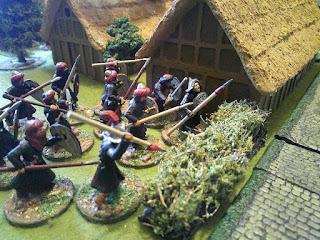This week was a Petaudia campaign week and so I got on and played the attack on the priory game I mentioned previously as the next scheduled action. Dragon Rampant rules (with a few home amendments), which I find to be more and more suitable for solo games. As before, the Kedarian Horse Tribes are attacking; the Priory of St. Menno of the Church of Ferrex is defended by peasants and the Church's own troops (it being a "Church militant" far more than a "Church pacifist" - it is a dangerous continent to live in!), with a possible relief force from the nearby Barony of Gonfalon.
I played the defenders, choosing to hold two buildings with the Church's troops and hope my peasants might manage something out in the fields. That was a mistake! I should have got them into the priory complex a.s.a.p. and used them to hold buildings as well. For the Kedarians, the Non-player army, I fought them with the following "standing orders", as it were:
Light Cavalry - shoot and scoot, keep away from heavy stuff; Heavy Cavalry - support the Light Cavalry and mop up easy targets; spearmen - storm the buildings and plunder; bowmen - support the spearmen.
The battle ended with a victory for the Kedarians, although time was called when they had lost half their attack force, so it was not a walkover by any means. The peasants had a bad day, as always! The Church troops held on in the priory, but the relief column had mixed fortunes.
Here are some photographs:
Scenario Rules: Attack on a priory.
a) Terrain: main road north to south, main priory building and three out-buildings, orchard, walls, etc., to east of main road.
b) The Horse Tribes enter on the east edge. The three units of peasants are in the fields to the west of the main road and north of the priory, deployed individually at least 2” apart. One priory garrison unit is in the priory building, one in an out-building.
c) The Horse Tribes must loot and burn the priory and its outbuildings; the defenders must prevent this occurring.
d) The peasants have to pass a “Move” activation test to form up as a unit before they can take any action against the attackers. Any villager who is contacted by a Horse Tribe unit whilst on their own is immediately overrun. Once the group has united, it moves and fights as a normal unit.
e) The garrison units also have to pass a “Move” activation test to form up in the courtyard of the priory complex. However, they can remain in their building and defend it against an attack without having to pass a “Move” activation test.
f) A Horse Tribe foot unit which is in contact with an undefended building can elect to loot and burn it that turn as long as it passes an “Attack” activation test. Once looted, the building is set on fire and the unit must move to the east edge of the table to dispose of its loot before returning to the action. If a Horse Tribe unit is attacked while looting and burning a building they fight as “Battered”.
g) At the end of Turn 6, roll 1D6. If 5 or 6, Castle Gonfalon force arrives on road south edge of table at start of next turn. These will aid the priory. Continue to roll each turn thereafter until the reinforcements have arrived or the game ends. If the reinforcements arrive, each unit requires a “Move” activation to enter the table.
h) The game ends when either side have lost half their points (i.e. they give up the fight) or all the buildings are looted and burned (i.e. the Kedarians have a clear win) or the unit including the Horse Riders’ leader is destroyed (i.e. the Kedarians lose their leader and so their motivation).
i) Victory Points
Horse Tribes: 10 VP per building looted and burned; 1 VP per enemy figure killed; 50VP bonus if all the priory buildings are looted and burned
Village Defenders: 10 VP per building not looted and burned; 2 VP per enemy figure killed by peasants; 1 VP per enemy figure killed by Ferrex or Lamrian troops; 50 VP bonus if none of the priory buildings are looted and burned
Horse Tribes of Kedaria
Heavy Cavalry Cavalry 6 x figures Heavy Riders 7 Points x 1**
Light Cavalry Cavalry 6 x figures Light Riders 6 Points x 2
Bows Infantry 12 x figures Light Missiles 4 Points x 1
Spears Infantry 12 x figures Light Foot 4 Points x 3
*One unit includes the Horse Tribes’ leader.
Peasants Infantry 12 x figures Hordes 1 Point x 3
Foot Infantry 12 x figures Heavy Foot 6 Points x 1**
Ret. Longbows Infantry 12 x figures Light Missiles 6 Points x 1
Men-at-arms Cavalry 6 x figures Medium Riders 6 Points x 1**
Hobilars Cavalry 6 x figures Medium Riders 4 Points x 1
Spears Infantry 12 x figures Heavy Foot 5 Points x 1
Longbows Infantry 12 x figures Light Missiles 4 Points x 1
**Includes a leader.


































That gave a lovely narrative. I like the idea of giving one side standing orders. For solo gaming, I tend to just play both sides equally, with all the advantages and disadvantages that that brings - I will have a go at standing orders. Cheers.
ReplyDeleteIt came to me as an idea from old WRG Ancients rules, when units had standing orders. It seemed to work quite well.
ReplyDelete